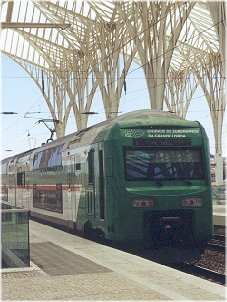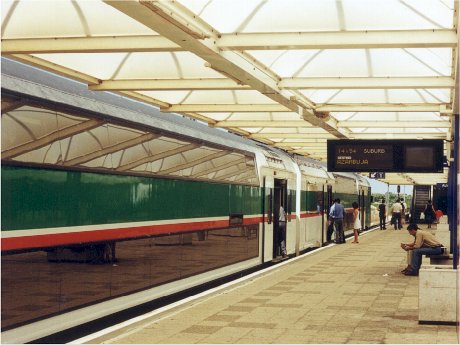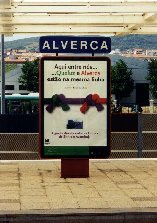Monte Abraão to Alverca (rush-hours only)
The Major Lisbon Stations
ALCÂNTARA-TERRA
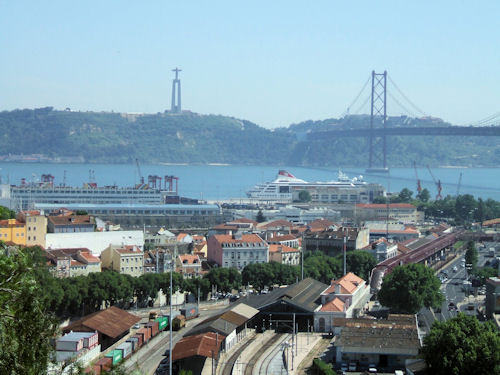
Above: From Prazeres cemetery can be seen Alcântara-Terra station is in the foreground. In the background are the Alcântara docks and the Ponte 25 de Abril.
Situated inland from The Alcântara-Mar station on the Cascais Line, this is a terminus station in western Lisbon normally only frequented by local residents. An unexpected vantage point (see above) to see the station complex is from the back of the Prazeres cemetery at the end of tram route 28. Azambuja services from Alcântara resumed from 22 February 1999 and were the last bastion of the old class 2000 EMU stock. Double-deck 3500 stock now operates here.
ENTRECAMPOS
This newly modernised (c1999) and extended station runs at high level across the
Avenida da República, one of Lisbon's main arteries to the north. The station complex accommodates not only the Azambuja Line but also Fertagus services across the Ponte 25 de Abril which spans the River Tagus.
ORIENTE
Designed by the Spaniard, Santiago Calatrava, this magnificent new station is one of the most striking in Europe, with its high, glazed roof support by slender pillars and with its sides completely open. It was opened in time for the Expo 98 events. Oriente is an interchange for long-distance services as well as with the Lisbon Metro. At the back of the station is a large bus interchange, which includes services which run across the Ponte Vasco da Gama to Setúbal and elsewhere.
ROMA-AREEIRO
A new (2004) station created by expanding the former Areeiro station and providing a long, covred walkway to a new entrance on the Avenida de Roma. Fertagus services to Setúbal share the station with Sintra/Azambuja line trains.
The Route from Entrecampos
A description of the Azambuja Line routes from beyond Entrecampos, can be found on the Sintra Line page.
ENTRECAMPOS (0km)
This modern station has striking wavy metal work along its sides but in its unpainted state and lack of external signage does not either make it look particularly attractive or easy to locate. The rambling station's new main entrance is from the Avenida 5 de Outubro into a new terminal building. Alternatively there is a subway at the Rego (west) end of the platforms. Some 200m to the west is the island platform of Entrecampos Poente (Entrecampos West) from where the família de Cacém trains start on their route along the Sintra Line via Cacém. A moving walkway was installed in 1999/2000 to link Entrecampos and Entrecampos-Poente.
The layout of the main Entrecampos station is four-tracks arranged in a 1P2P1 formation, where the numerals represent tracks and 'P' indicates a platform. Double-deck stock is now working on the Fertagus cross-river services as well as on the Azambuja Line. The trains to Alverca/Azambuja leave past the large Portugal Telecom building on the left and pass through some uninspriring urban landscape before passing under the Avenida da Roma roadway and entering a shallow cutting in a more salubrious area, formerly overlooked on the left by the Hotel Lutécia
and the Areeiro district to the right. The new covered entrance and walkway from the Avenida de Roma now obscures this view on the left.
ROMA-AREEIRO (3km)
The formerly unadorned station of Areeiro (P2P1) underwent a major development and renaming as Areeiro-Roma, which left it with a much enhanced and enlarged facility (2004). Between 1999 and 2000 Areeiro station had been allowed to decay and the platforms were weed-covered and adorned by graffiti. Now it is impressively light and airy and as with other Lisbon terminals has a security presence. It is a good five minute walk (above ground and poorly signed) from both Roma and Areeiro Metro stations. After leaving Roma-Areeiro the train shortly passes through scrubland and under the Metro line to Chelas, but a long and high apartment development briefly interrupts similar vistas to the left.
CHELAS (4km)
Although its platforms are new, this was an uninspiring halt (P2P) with a shelter which has been upgraded slightly since 2001 but is still a slightly intimidating setting with its shanties to the left. As the station is left, the line crosses a short viaduct. Newer apartments can be seen in the distance beyond a vista of derelict buildings near the track. This halt is a marked contrast to the clean modernity of the nearby but unconnected Chelas metro station. To the right can be seen part of the Lisbon docks.
MARVILA (4.5km)
Another slightly intimidating halt (P2P), formerly overgrown by weeds but now with new platforms and with a level crossing. However, the scrubland and depressing visual scene does improve after Marvila with a view to the right of the Vasco da Gama bridge over the Tagus and some better quality domestic building to the left. After here, the line joins the mainline from Lisboa Santa Apolónia to the right.
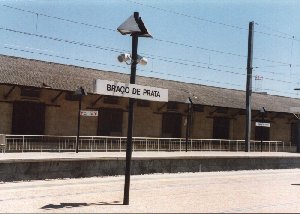
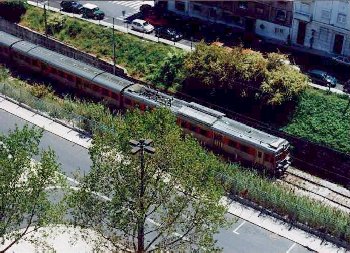
Left to right: Braço de Prata station; an EMU leaves Areeiro.
BRAÇO DE PRATA (5km)
This is an unadorned station (P2P2P), modernised c.2000, but now blighted by graffiti, with an overbridge, seats. As the station is left, heavy industry is evident to the right in the form of a gasworks, with random houses nearby. To the left is a concrete-sided cutting wall, before the view opens to reveal industrial plants. The Vasco da Gama bridge is now visible ahead, to the right, as is the start of the Parque das Nações, the site of the Expo 98 event. The Expo
cablecar, the Teleférico can also be seen, along with a number of pavilions and carparks. The track opens out into the eight platforms of...
ORIENTE (8km)
Variously cited as Lisboa Oriente, Estação do Oriente or Gare do
Oriente, (1P2P2P2P1), this is an architectural masterpiece by the Spaniard, Santiago
Calatrava. To the right can be clearly seen the Expo site, now termed the Parque das Nações (Nations' Park), the new Vasco da Gama shopping centre and Warner cinema. There are also good views of the Vasco da Gama bridge stretching into the distance across the Tagus. A new Melia hotel tower was erected (summer 2000) nearby. Well-worth visiting here are the Oceanarium, the cablecar and the Vasco da Gama tower. Pictured left, a class 5600 inter-city service passes under the Ponte Vasco da Gama as it approaches Oriente from the north.
MOSCAVIDE (9km)
This new (c2000) halt (P2P) is to the right of the mainline tracks and was formerly
the location of lengthy waits for suburban trains awaiting clearance ahead.
After the station, which until recently was known as Moscavide Sul, there are tower blocks of apartments and a sports stadium (Estádio Sport Grupo Sacavense) to the left, whilst the right side is open towards the Tagus apart from the motorway to the north.
SACAVÉM (10km)
This is another refurbished station (P2P2P) with an overbridge. On the left can be seen the old station watertower with the station name in large letters upon it. There are good views of the Vasco da Gama bridge from the station. Behind the buildings to the left is the end of the main runway of Lisbon Airport. After leaving the station, the tracks
cross a small river and go under a motorway junction. Whilst there is reasonably good quality housing to the left, to the right there is industry, with GALP gas or fuel containers in evidence.
BOBADELA (14km)
This newly modernised (1999) station (P2P2P) was very soon a victim of graffiti vandals. The
motorway is now some 200 metres away, to the right. To the left is the large factory of José Olaio whose name adorns a tall red chimney. Nearby is a long freight yard with wagons, car transporters and locos often visible on either side of the track, but especially on the right. There is often a nasty chemical smell in this area from the nearby industrial works. A track bed rises from the right to cross above the Azambuja lines and then it descends on the left of the lines. Factories continue to the left, including the paint works of Tintas Robbialac and there is a refinery to the right, with BP fuel/gas holders.
SANTA IRIA (15km)
Another modernised station (P2P2P) set amidst industry and refineries. After passing under a roadway the Solvay Portugal chemical works are evident to the right, preceded by what appear to be a number of disused salt or chemical pans. To the left are some derelict industrial premises.
PÓVOA (18km)
This is also a very recently revamped station (P2P2P) with a substantial pedestrian overbridge. As the train leaves the station, the substantial town can be seen to the left, whilst the industrial plants continue to the right. The housing gives way to more industry on the left. A track veers off left to rise above the Azambuja Lines and descend again on the right-hand
side of them. Then, to the left, can be seen the railway yards of the chemical company, Quimigal. Over to the right in the distance, on the Alverca air force base can often be seen a number of old aircraft, including Douglas piston-engined transport aircraft. In 2005 the base was being touted as an airport for budget flights to Lisbon, for which its rail connections would be a great boon.
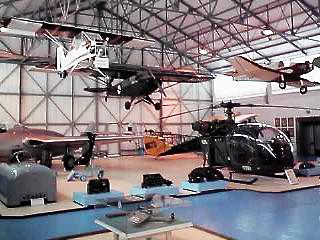
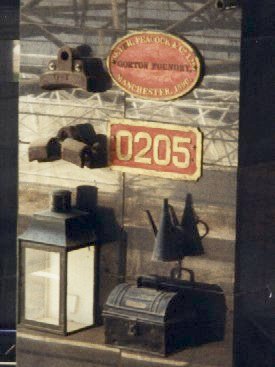
L to R: The Museu do Ar (Air Museum) which lies immediately alongside the
Azambuja railway line, at Alverca; artefacts on the station-bridge pillars include a plate from the Bayer-Peacock works at Gorton, Manchester.
ALVERCA (22km)
This modern station (1P2P1) has an interesting overbridge on which are housed not only the ticket office but also a newsagent's, shops and a pleasant bar, called Entre-Linhas (Between the Lines) with old railway photographs on the wall. To reach this, there are escalators, alongside which the roof supports are adorned by railway memorabilia, including British Bayer-Peacock locomotive plates, locomotive lamps and other items from old CP stock. From the right-hand side of the bridge there is a view of the outdoor exhibits of the Museu do Ar (Portuguese Air Museum) which include a Fiat G91 replica. The museum is literally only 100 metres from the station and is well worth a visit. To the left of the station is a small bus station and beyond that, the town of Alverca. Just after the overbridge are central tracks used as stabling for double-decker stock, whilst to the right is an aviation engineering complex where C-130 Hercules can sometimes be seen near the track. To the left is the floodlit stadium of Alverca football club. The river estuary appears again to the right and some sizable vessels can sometimes be seen on this stretch near the now semi-derelict premises of the Argibay shipyards, which can be seen, right, next to the track. A number of the present-day cross-Tagus river ferries were built here. As derelict factories appear to the right, the left offers distant views of hills behind built-up areas. An old railway turntable is still evident at the Milóleo factory to the right, which has its own sidings and cereal hoppers. The MACOL (Macedo e Coelho) factory is also passed on the right-side. On the left are the Ciarga and Iberol factories. As the train slows, to the left, there is the soil-surfaced Campo da Hortinha, the compact stadium of Alhandra Sporting Club.
ALHANDRA (27km)
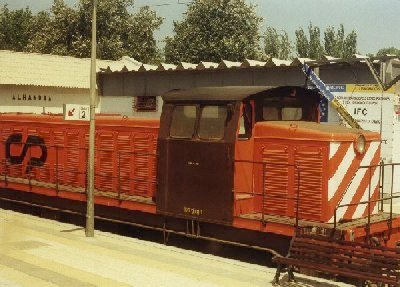 This P2P station retains its attractive old station building to the right but unsightly pipelines cross the lines at the station. Class 1200 locos can often be seen here on workings to the nearby cement works, (1208 is seen left). On leaving the station an elevated road appears to the left, parallel to the track, whilst the now broad Tagus estuary, with its islands, is visible to the right. The halt of QUINTA DAS TORRES (30km) is passed, with a military complex adjacent to it (left). To the left is the cement works. The Vila Franca de Xira bull-ring (in yellow and red) and a football stadium can also be seen to the left as the impressive spans of the General Carmona bridge at Vila Franca de Xira loom into view over the Tagus, to the right. Until the opening of the Ponte Salazar (now Ponte 25 de Abril) in 1966, this was the lowest fixed crossing of the Tagus. After a level-crossing, the train enters V.F. de Xira.
This P2P station retains its attractive old station building to the right but unsightly pipelines cross the lines at the station. Class 1200 locos can often be seen here on workings to the nearby cement works, (1208 is seen left). On leaving the station an elevated road appears to the left, parallel to the track, whilst the now broad Tagus estuary, with its islands, is visible to the right. The halt of QUINTA DAS TORRES (30km) is passed, with a military complex adjacent to it (left). To the left is the cement works. The Vila Franca de Xira bull-ring (in yellow and red) and a football stadium can also be seen to the left as the impressive spans of the General Carmona bridge at Vila Franca de Xira loom into view over the Tagus, to the right. Until the opening of the Ponte Salazar (now Ponte 25 de Abril) in 1966, this was the lowest fixed crossing of the Tagus. After a level-crossing, the train enters V.F. de Xira.
VILA FRANCA DE XIRA (31km)
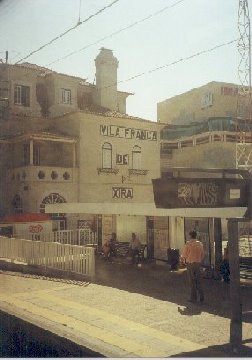 This busy little town is the terminus (P2P) for some Lisbon services (emanating from Alcântara-Terra) and retains an attractively tiled station building (left). A pleasant park lies to the right of the station. After passing under the Carmona bridge approach road, a Nissan/Hyundai complex is visible (right). The main road runs parallel to the left where flats and other buildings contrast with open land to the right. A range of hills, surmounted by a transmitter, gradually moves away from the railway (left). The town boasts a substantial hotel next to the line (left) near some road-toll booths.
This busy little town is the terminus (P2P) for some Lisbon services (emanating from Alcântara-Terra) and retains an attractively tiled station building (left). A pleasant park lies to the right of the station. After passing under the Carmona bridge approach road, a Nissan/Hyundai complex is visible (right). The main road runs parallel to the left where flats and other buildings contrast with open land to the right. A range of hills, surmounted by a transmitter, gradually moves away from the railway (left). The town boasts a substantial hotel next to the line (left) near some road-toll booths.
A new station ("Vila Franca de Xira Norte") is being built and, between Vila Franca and Azambuja, much other work is being undertaken to improve the route, with additional tracks being laid (2005).
CASTANHEIRA DO RIBATEJO (35km)
This halt (P2P) is next to fields (right). To the left appears the Metal-Portugal works and chimneys and other light industry, whilst an old lorry scrapyard is sited to the right of the track. A car-auction site is visible to the left and a small Renault complex is housed in the town.
CARREGADO (37km)
The two narrow platforms (P2P) house, left, a substantial but fairly modern station building with a separate modern toilet building. After leaving the station over a level-crossing, a large factory/refinery with three tall chimneys and gas holders stands out (left) with open country and hills beyond it. Three disused tracks run for some distance along the right-side. A small town is visible left as the train approaches the next stop.
VILA NOVA DA RAINHA (41km)
Alarmingly, this small and quiet station (P2P) in 2001 had disquieting bullet holes through its nameboards on the right-hand platform! The town it serves (left) has an attractive little church. Factories, housing and fields full of new Opel cars are seen to the left, with fields to the right.
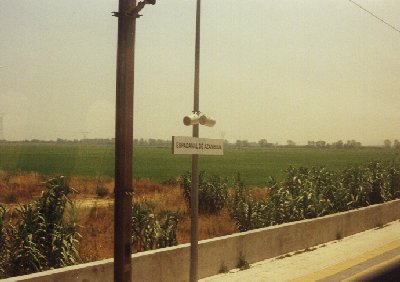 ESPADANAL DE AZAMBUJA (44km)
A large Opel factory is sited on the left, with thousands of parked cars, sidings and car-transporter wagons on them. There is also a large Modis supermarket distribution centre for the Continente and Modelo chain of shops on the left. The station itself is modest (see right). Dried-up water tanks lie to the right. A cemetery by the road side (left) marks the approaches to Azambuja.
ESPADANAL DE AZAMBUJA (44km)
A large Opel factory is sited on the left, with thousands of parked cars, sidings and car-transporter wagons on them. There is also a large Modis supermarket distribution centre for the Continente and Modelo chain of shops on the left. The station itself is modest (see right). Dried-up water tanks lie to the right. A cemetery by the road side (left) marks the approaches to Azambuja.
AZAMBUJA (47km)
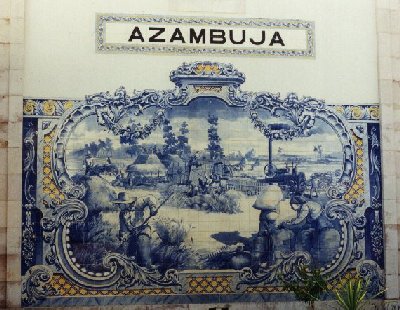 The double track becomes four-track as the train enters the station (P1P2P1), which has a fine main building adorned at each end by magnificent tilework depicting local scenes (see illustration). The station has otherwise been extended and modernised with a large overbridge which crosses both the tracks and the roadway (left of the tracks). This is the terminus for the Azambuja line but the lines go forward towards Santarém and beyond. Across the busy road from the station is the town, which has little to interest the visitor but does have some cafés, a post office and other facilities. The Café O Licínio, opposite the post office, is a handy staging post near the station. Services can be caught from here to Santarém and beyond, up the Tagus estuary, along the main line to Coimbra and Oporto.
The double track becomes four-track as the train enters the station (P1P2P1), which has a fine main building adorned at each end by magnificent tilework depicting local scenes (see illustration). The station has otherwise been extended and modernised with a large overbridge which crosses both the tracks and the roadway (left of the tracks). This is the terminus for the Azambuja line but the lines go forward towards Santarém and beyond. Across the busy road from the station is the town, which has little to interest the visitor but does have some cafés, a post office and other facilities. The Café O Licínio, opposite the post office, is a handy staging post near the station. Services can be caught from here to Santarém and beyond, up the Tagus estuary, along the main line to Coimbra and Oporto.
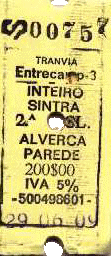
Tickets
As well as normal single/return tickets, the implementation of sophisticated
self-service ticket machines means that Multiviagem tickets allowing
unlimited travel within specified numbers of zones are now available. The options
range from a one-day, one-zone ticket to eight-zone tickets for seven days. Ten-journey tickets can also be had for any number of zones. Shown here is an old, manually-purchased ticket from
Entrecampos to Alverca (summer, 1999).
Rolling Stock
New double-deck stock (designated type UQE2P, class 3500) made its service appearance in autumn, 1999, after deliveries had begun the previous July. The initial service between Oriente and Vila Franca de Xira, via Alverca, ran on 9 September 1999. For further details, see the Lisbon Railways Part 2 page.
My thanks are due to Willy Kaemena for some of the information on this page; Willy's website is well worth a visit.
Copyright: 2015 ©
Copyright: ©
Contact: the following is not a link; please transcribe the address into your email  .
.
No responsibility can be accepted for the consequences of any errors on this website.


 9 July 2005
9 July 2005 

